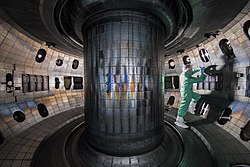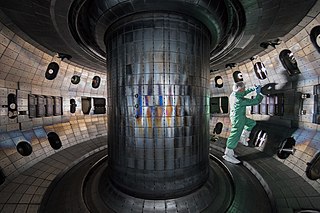
A tokamak is a device which uses a powerful magnetic field generated by external magnets to confine plasma in the shape of an axially symmetrical torus. The tokamak is one of several types of magnetic confinement devices being developed to produce controlled thermonuclear fusion power. The tokamak concept is currently one of the leading candidates for a practical fusion reactor.

Princeton Plasma Physics Laboratory (PPPL) is a United States Department of Energy national laboratory for plasma physics and nuclear fusion science. Its primary mission is research into and development of fusion as an energy source. It is known for the development of the stellarator and tokamak designs, along with numerous fundamental advances in plasma physics and the exploration of many other plasma confinement concepts.
This timeline of nuclear fusion is an incomplete chronological summary of significant events in the study and use of nuclear fusion.

The Joint European Torus (JET) was a magnetically confined plasma physics experiment, located at Culham Centre for Fusion Energy in Oxfordshire, UK. Based on a tokamak design, the fusion research facility was a joint European project with the main purpose of opening the way to future nuclear fusion grid energy. At the time of its design JET was larger than any comparable machine.
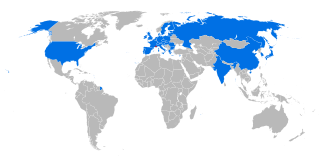
ITER is an international nuclear fusion research and engineering megaproject aimed at creating energy through a fusion process similar to that of the Sun. It is being built next to the Cadarache facility in southern France. Upon completion of construction of the main reactor and first plasma, planned for 2033–2034, ITER will be the largest of more than 100 fusion reactors built since the 1950s, with six times the plasma volume of JT-60SA in Japan, the largest tokamak operating today.
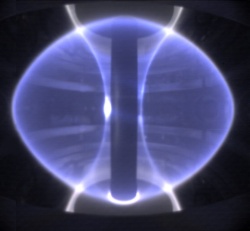
Magnetic confinement fusion (MCF) is an approach to generate thermonuclear fusion power that uses magnetic fields to confine fusion fuel in the form of a plasma. Magnetic confinement is one of two major branches of controlled fusion research, along with inertial confinement fusion.

Alcator C-Mod was a tokamak that operated between 1991 and 2016 at the Massachusetts Institute of Technology (MIT) Plasma Science and Fusion Center (PSFC). Notable for its high toroidal magnetic field, Alcator C-Mod holds the world record for volume averaged plasma pressure in a magnetically confined fusion device. Until its shutdown in 2016, it was one of the major fusion research facilities in the United States.

The National Spherical Torus Experiment (NSTX) is a magnetic fusion device based on the spherical tokamak concept. It was constructed by the Princeton Plasma Physics Laboratory (PPPL) in collaboration with the Oak Ridge National Laboratory, Columbia University, and the University of Washington at Seattle. It entered service in 1999. In 2012 it was shut down as part of an upgrade program and became NSTX-U, for Upgrade.

The KSTAR is a magnetic fusion device at the Korea Institute of Fusion Energy in Daejeon, South Korea. It is intended to study aspects of magnetic fusion energy that will be pertinent to the ITER fusion project as part of that country's contribution to the ITER effort. The project was approved in 1995, but construction was delayed by the East Asian financial crisis, which weakened the South Korean economy considerably; however, the project's construction phase was completed on September 14, 2007. The first plasma was achieved in June 2008.
The beta of a plasma, symbolized by β, is the ratio of the plasma pressure (p = nkBT) to the magnetic pressure (pmag = B2/2μ0). The term is commonly used in studies of the Sun and Earth's magnetic field, and in the field of fusion power designs.
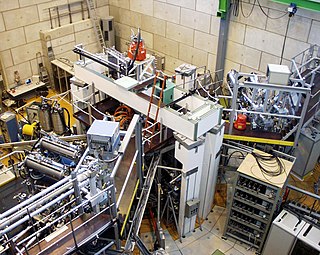
The tokamak à configuration variable is an experimental tokamak located at the École Polytechnique Fédérale de Lausanne (EPFL) Swiss Plasma Center (SPC) in Lausanne, Switzerland. As the largest experimental facility of the Swiss Plasma Center, the TCV tokamak explores the physics of magnetic confinement fusion. It distinguishes itself from other tokamaks with its specialized plasma shaping capability, which can produce diverse plasma shapes without requiring hardware modifications.
Resonant magnetic perturbations (RMPs) are a special type of magnetic field perturbations used to control burning plasma instabilities called edge-localized modes (ELMs) in magnetic fusion devices such as tokamaks. The efficiency of RMPs for controlling ELMs was first demonstrated on the tokamak DIII-D in 2003.
The Tokamak de Fontenay-aux-Roses (TFR) was the first French tokamak, built in a research centre of the French Atomic Energy Commission (CEA) in Fontenay-aux-Roses, a commune in the southwestern suburbs of Paris. The project was spearheaded by Paul-Henri Rebut, and is sometimes jokingly referred to as the "Tokamak façon Rebut" – a pun on the name Rebut and the French word "rebut" meaning "rubbish".
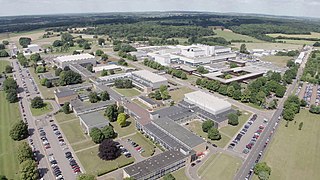
The Culham Centre for Fusion Energy (CCFE) is the UK's national laboratory for fusion research. It is located at the Culham Science Centre, near Culham, Oxfordshire, and is the site of the Joint European Torus (JET), Mega Ampere Spherical Tokamak (MAST) and the now closed Small Tight Aspect Ratio Tokamak (START).
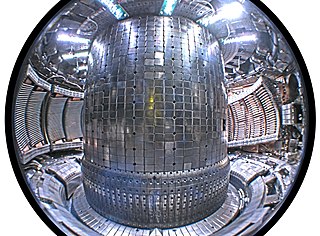
In nuclear fusion power research, the plasma-facing material (PFM) is any material used to construct the plasma-facing components (PFC), those components exposed to the plasma within which nuclear fusion occurs, and particularly the material used for the lining the first wall or divertor region of the reactor vessel.
In plasma physics and magnetic confinement fusion, the high-confinement mode (H-mode) is a phenomenon and operating regime of enhanced confinement in toroidal plasma such as tokamaks. When the applied heating power is raised above some threshold, the plasma transitions from the low-confinement mode (L-mode) to the H-mode where the energy confinement time approximately doubles in magnitude. The H-mode was discovered by Friedrich Wagner and team in 1982 during neutral-beam heating experiments on ASDEX. It has since been reproduced in all major toroidal confinement devices, and is foreseen to be the standard operational scenario of ITER.
Tihiro Ohkawa was a Japanese physicist whose field of work was in plasma physics and fusion power. He was a pioneer in developing ways to generate electricity by nuclear fusion when he worked at General Atomics. Ohkawa died September 27, 2014, in La Jolla, California, at the age of 86.
The history of nuclear fusion began early in the 20th century as an inquiry into how stars powered themselves and expanded to incorporate a broad inquiry into the nature of matter and energy, as potential applications expanded to include warfare, energy production and rocket propulsion.
Raffi M. Nazikian is a physicist known for his contributions to nuclear fusion research and plasma physics. He has been associated with the Princeton Plasma Physics Laboratory (PPPL) and has conducted significant work at the DIII-D National Fusion Facility.
